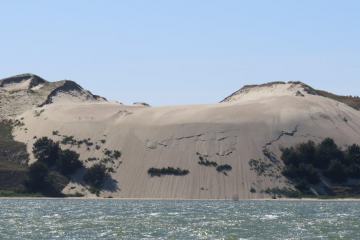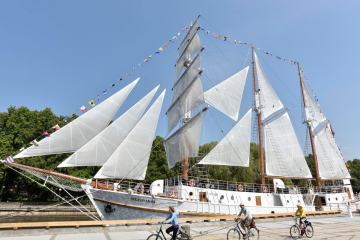
Testimonials
Did you know?
Total area: 65,300 sq. km. Nearly one third of the territory is covered by forests, 4.5% – by inland waters. There are over 2,800 lakes larger than 0.5 hectares in size, and 18 rivers longer than 100 kilometres in Lithuania
Baltic Coastline: Lithuania holds only a 90 kilometre long area of the Baltic Sea coast.
Lithuanian Seaside Cycle Route is the first and only signposted good quality cycle route in the country (more information www.bicycle.lt/seasideroute/).
Is Lithuania in the geographic centre of Europe? True, it lies just 24 kilometres northwest of Vilnius as the National Geographic Institute of France confirmed in 1989.
Climate: oceanic/continental. Average temperature in July is +17°C, in January – -4.9°C.
Lithuania is typically a sunny place to visit with sunny summers and bright winters. Lithuania is in the same latitude as Scotland, and the area has a continental climate – long cold winters; short hot summers, and it can rain a lot. Daytime temperatures should vary from 20˚C degrees to 33˚C degrees, cooler in bad weather. Nights will be cool to warm, never being cold – perhaps chilly in bad weather. There is generally a good amount of sunshine during summer months and the days are very long in June and July. The brightest months are usually May to August, with July being the warmest month of the year. This is a good time to visit the beautiful Curonian Spit and bask in the warm sun and seaside atmosphere.
Local Time: Central European Time zone. GMT + 2 hours, or same as, for Helsinki, Riga, and Tallinn.
Population: 2.5 million (+ more than 1 million which is in emigration)
Ethnic Composition: Lithuanians – 83.5%, Polish – 6.7%, Russians – 6.3%, Belarusians – 1.2%, others – 2.3%.
Language: Lithuanian - which is among the 10 oldest languages still spoken in the World today. The language family that most European languages belong to is Indo-European, but they started splitting apart from each other probably around 3500 BCE. They developed into dozens of other languages like German, Italian, and English, gradually losing the features that they had all shared. One language, however, up in the Baltic language branch of the Indo-European family, retained more of the feature of what linguists call Proto-Indo-European (PIE), which is the language that they postulate was spoken around 3500 BCE. For whatever reason, Lithuanian has kept more of the sounds and grammar rules from PIE than any of its linguistic cousins, and can therefore be called one of the oldest languages in the world. More information
Religion: Roman Catholic approximately 80% of the total populatio. Other confessions include Orthodox, Old Believers, Lutheran, Reformat, Judaist, Sunni, Karaite and other communities.
State structure: democratic parliamentary republic
National day: 16th of February and 11th of March (Independence Day)
State language: Lithuanian.
Currency: Euro (EUR) from 2015
Capital: Vilnius - 555,6 thousand.
Other Largest Cities: Kaunas – 364,1 thousand; Klaipėda – 188,8 thousand; Šiauliai – 130,0 thousand; Panevėžys – 116,3 thousand.
Distances: to Helsinki 720 km, to Berlin 850 km, to Moscow 830 km.
Time: GMT +2, from April to November GMT +3
Climate: Lithuania is typically a sunny place to visit with sunny summers and bright winters. Lithuania is in the same latitude as Scotland, and the area has a continental climate – long cold winters; short hot summers, and it can rain a lot.
Weather: There is generally a good amount of sunshine during summer months and the days are very long in June and July. The brightest months are usually May to August, with July being the warmest month of the year. Daytime temperatures should vary from 20˚C degrees to 33˚C degrees, cooler in bad weather. Nights will be cool to warm, never being cold – perhaps chilly in bad weather.
For more information about Lithuania and tourism services look on official tourism website HERE









